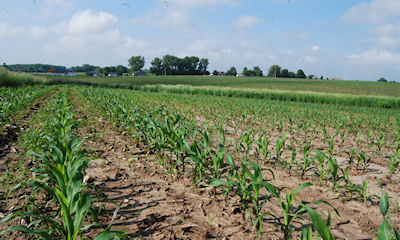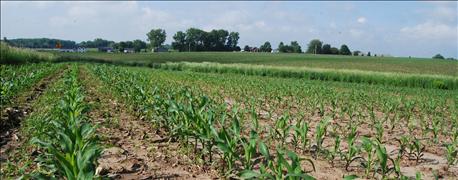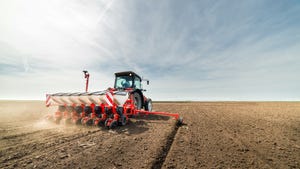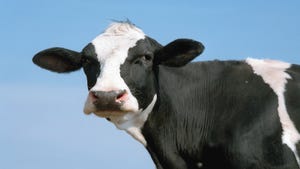

TIMELY TOPICS: With rain showers that keep popping up, it's been a continual battle to get bean planting finished and weed spraying done in corn in wet areas of Iowa. Nitrogen loss in corn, late planting beans and spray drift are timely topics.
It has been a continual battle to get bean planting done and work completed on post-spraying weeds in corn, especially in the wetter areas of Iowa this spring. "In southwest Iowa, our ISU Armstrong Research Farm superintendent, Bernie Havlovic, says there was rainfall 21 of the 31 days in May. June has been just as uncooperative with I think nine days of measurable rainfall so far," says Iowa State University Extension field agronomist Clarke McGrath. "Some locations have had even more rain, and heavier rains than our Armstrong farm near Lewis. We've fared relatively well on growing degree units to date; spot checks show that while a little behind average, a few warmer days and nights would get us about to average."
Getting the corn post work wrapped up has been a bear, so double check corn height and cross-check with your herbicides to ensure they are within label, he advises.
Nitrogen loss in cornfields, concern increases with wet weather
Concern over this topic has increased over the last week or 10 days; most of the "planned" sidedress nitrogen has been applied, so the focus has shifted to fields that had a full rate applied preplant. With the corn getting some size to it folks are on the fence as to if they should worry about additional N since applications on big corn can be pretty challenging with ground rigs and a little more costly by air. There aren't any perfect answers to this, but an article by ISU Extension soil fertility agronomist Dr. John Sawyer gives some good guidance extension.iastate.edu/CropNews/2015/0609Sawyer.htm.
Corn diseases starting to show up already in some Iowa fields
"Unfortunately corn diseases are showing up already; anthracnose can be found about anywhere if you look hard enough, but typically this early in the year we don't get too worried about it," says McGrath. "Seeing northern corn leaf blight is a little more troubling, but if the weather pattern shifts to drier weather it may not become a huge issue. If we stay cool and wet though, look out. ISU Extension plant pathologist Dr. Alison Robertson covers what to watch for."
Do you have bean acres left you are still considering planting?
"In discussions with retail and farmer friends from southern Iowa, they all indicate that there are a significant number of bean acres left to wrap up in parts of southwest and south-central Iowa, and down into Missouri," says McGrath. He provides the following link to an article from University of Missouri that addresses "some later planted soybean strategies, and it applies very well to southern Iowa and probably most concepts would apply further towards the center of Iowa, too."
McGrath adds, "The one thing I would adapt for our area is that while Missouri University agronomists say to wait until July to shift to earlier soybean maturities, we generally would look at shifting half a group earlier starting now in mid-June. For example if your original plan was to plant a 3. Maturity bean variety, it is probably going to give you better odds of making maturity if you move to something around a 2.5."
~~~PAGE_BREAK_HERE~~~
Another point that McGrath discussed was the MU recommendation to up planting rates by 30,000. "Our ISU data doesn't show a consistent benefit to that, however some Iowa Soybean Association work does. We're working on adding to the database to fine tune that recommendation, in the meantime ask your seed agronomist for their later planting rate recommendation on the varieties you are planting."
Drift management is needed this time of year with post spraying
Every spray season, especially at postemerge time, it seems at least half the days or more the wind is blowing, fields are wet, and crops are growing closer to the upper height limits of the herbicide label while sprayers sit idle. At the same time, the weeds seem to double daily in size and compete longer with crops for valuable resources like water, nutrients and sunlight.
"This season it seems like it has been more challenging than most," says McGrath. "I have to give credit where credit is due; folks are doing a great job so far, phone calls with questions or reports about drift are about where they are on average which is impressive given the small windows for spraying we've had this year. Corn postemergence spraying work is moving along and we'll hopefully be moving on to the beans soon if the weather cooperates. Now is when things can get exciting, as the corn takes off there is more urgency to get that done so we may push the envelope. After looking at some of the bean fields, we'll be pushing the limits on some of those post trips as well, so herbicide drift management will become even more critical."
Factors you can control when spraying herbicides and pesticides
McGrath offers the following guidelines and information to help you avoid problems with spray drift. "Experiencing this phenomenon firsthand in my days of working at a retail farm chemical dealership and custom spraying business, and working with sprayers on farms, has taught me to focus on what you can control when you can get back in the field: application time, boom height, sprayer speed, pressure, nozzle type and wear, carrier rates and additives."
About the Author(s)
You May Also Like




